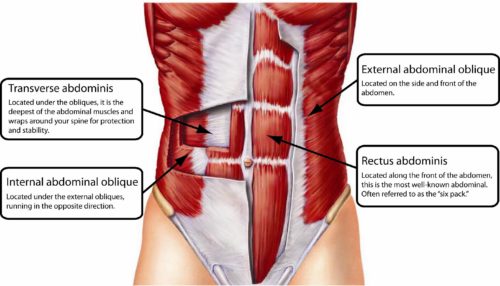I love when people ask me before class, “Hey, I really would love if you’d focus on core today!”
To that I say, “Hey, I focus on core every day!”
Because really, shouldn’t we have “core awareness” in every pose we do, with the exception of restorative poses like Child’s Pose and Shavasana?
Now, without getting into the different kinds of muscular contractions (eccentric, concentric and isometric), let’s just focus first on the idea of the “core” itself. And, to further help us frame this conversation, let’s focus on the 4 key core muscles, versus muscles that are in the center of the body but have other key functions besides being a muscle of the core ( for instance, the psoas, which is a hip flexor).
Overview
So, now that we’ve framed the discussion, let’s be sure we know the 4 core key muscles. So, let me give you a minute. What are the 4 key abdominal muscles? It doesn’t have a cool acronym like the rotator cuff (“SITS”) but there are four. They are:
- transversus abdominus
- rectus abdominus
- internal oblique
- external oblique.
Here’s an image that will help you with the visual:

These muscles have key functions to assist you in activities of daily living as well as yoga. Just briefly:
- The transversus abdominus is like a corset around the body. It keeps the abdominal contents “in” and closely tucked into the body and supports the lower back. You can contract it if you focus on drawing the sides of the body inward;
- The rectus abdominus is that long line up the center of the body from the pubic bone to the sternum. Most like the “six pack ab” muscle in common vernacular, it contracts when we do an abdominal crunch;
- The internal oblique and external oblique work collaboratively in twisting motions. I wrote an extensive blog post on these muscles alone which you can read here.
So, now that we’ve outlined the muscles of the core, how is it that we can say that we use them just about all the time in yoga practice? Well, this gets to a broader concept in anatomy and yoga. It’s what I refer to as bringing “integrity to the pose.” (not that I’m the first one to say that, I’m sure!)
My point is this: if we want all the shapes of each pose to exhibit just the right amount of stretch and strength, AND if we consider the core to be, of course, the center of the body, then it pretty much stands to reason that in order for each pose to have integrity, or  “proper shape”, we’d need to be using our core in one way or another, and one or some of these muscles at the same time. For if we’re not, the pose will most likely “slump” or not have what I call, “integrity.”
Here are some examples:Â
Cuing to the “center line” of the body in Tree pose (rectus abdominus)
Cuing to “drawing into the center line” in Triangle (rectus abdominus)
Cuing to “drawing the sides of the body in” when moving from high to low push up (tranversus)
Cuing to rotating through the right (or left) side body in Prayer Twist (obliques).
This also brings up a concept in yoga which has to do with the idea of cues from the “ground up” or the “center out.” I like to switch it up, depending on the pose, for instance. I like to think about how to cue depending on the pose I’m teaching. So, something like Tree pose works nicely when you cue from the “ground up.” But something like Triangle or Crow work nicely when cueing from the “center out.” These are just different things you can play with as you think about the best way to communicate with your class and help them tap into their anatomy.
If you like to learn about the anatomy of yoga, I’ll be you’d be interested in my anatomy manual, called “The Bare Bones Yoga Guide to Anatomy.” Filled with soup to nuts information for yoga teachers about how to understand this highly complex topic AND apply it to your teaching, you can get it on my website ($65). Also, just to give you a heads up: This is the precursor to my next online course and everyone that has my manual gets the course at a discount! This course will bring the manual to life, so they will partner well together. That next course, “Your Yoga Anatomy Blueprint” will be ready within the next month or so.
One of my anatomy manual students had this to say about it:
Karen I love your manual. I completed my 200 hour at a Baptiste studio
in April 2016, and now teach there. Your manual has really helped me
bring anatomy into my teaching, which is important to me. Being a new
teacher it makes me more confident. So thank you?.
Have a great day,
Shawn
If you’d like to purchase the manual, just click here. And, if you buy it, I’ll give you access to my second online course, on “Moving from High to Low Push Up,” for free! ($20 value). You can check the courses out here.
Thanks for reading!
